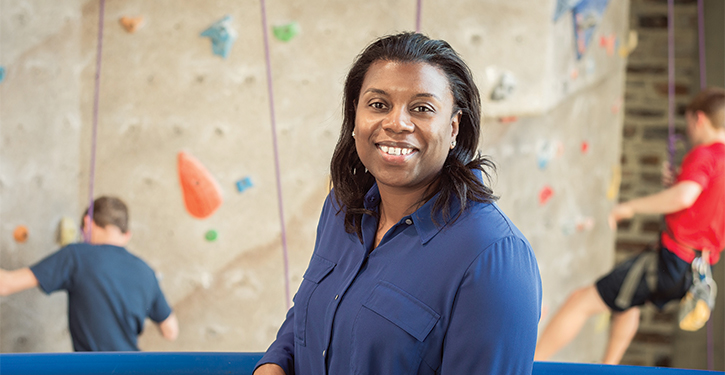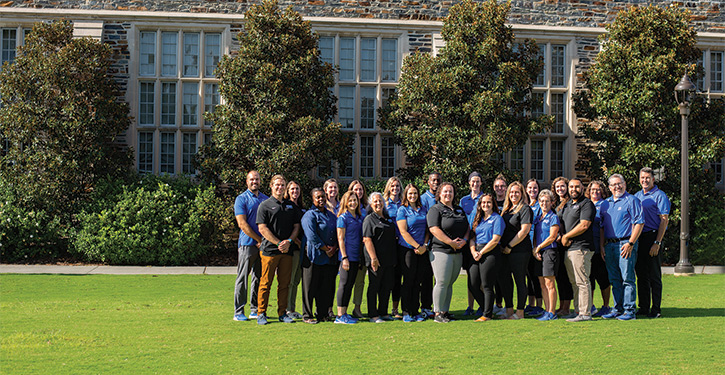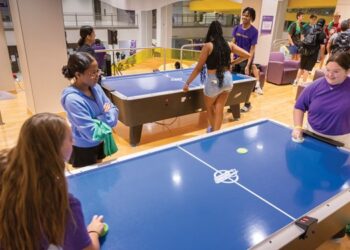When Felicia Tittle ventures out of her office at Duke University, she sees something that still makes her emotional to this day: students hanging out eating at the cafe in the facility.
“This is what it’s all about,” said Tittle, the executive director of Duke Recreation & Physical Education. “This is what you’re supposed to do — hanging out, building relationships, getting to know people you normally would not know.”
What makes Tittle emotional is the fact when she first arrived at Duke in 2009, the campus rec facilities had little to no space for students to hang out. “When I was interviewing, I was like, ‘Wow, where do they even sit?’” she recalled. “It was not designed for them to stick around, and so that means it’s hard to create programming with intentionality.”
The evolution of Duke Recreation & Physical Education has been tangible in the facility since the start of Tittle’s tenure. She described it as moving from transactional to transformational spaces.
EXTRA CREDIT: Who is Felicia Tittle? Learn more here.
But to even recognize the changes the physical space needed, they had to have a clear mission, vision, value and charter. “The first step was creating an identity,” said Tittle. “Who are we?”
It’s a big question, but since Tittle asked it, Duke Recreation & Physical Education has built an even larger answer.
Part of that answer involves the physical spaces campus rec exists in at Duke. The department has two recreation centers located on different parts of the campus. Wilson Recreation Center is on West Campus and Brodie Recreation Center on East Campus. Brodie is 50,000 square feet while Wilson is the larger of the two at 99,000 square feet.
However, each uniquely serves students at Duke. For example, due to its location Brodie is designed to target first year students and has programming to match. “We do a lot of programming for first year students there to try to get them in touch with wellness, what it means to get involved and to communicate,” said Tittle.
There’s a lot of intentionality in how the team at Duke programs. This includes having a focus on inclusion and accessibility.
Unified Sports and Adaptive Climbing at Duke University
The Unified Sports program has been drawing in student volunteers and athletes in the local Durham, North Carolina, community for almost a decade. “Our partnership with Durham County Parks & Recreation and Special Olympics North Carolina has been instrumental in the success of our Unified Sports,” said Brittany Burriss, the coordinator of Intramural Sports.
One highlight of the program is the Unified Basketball Rivalry Series. Burriss’ favorite event is the Duke versus University of North Carolina Unified Rivalry game. “This event has a rich history, the participants are full of great energy and the game is always competitive,” she said. “Our partners and athletes are always excited to compete against another unified team, and they talk about and anticipate this game months in advance.”
When it came to advice for other rec professionals looking to build their own Unified Sports offering, Burris noted it’s key to connect with your local Special Olympics state programs and community organizations. Have a consistent day and time for the league’s schedule, and recruit good student leaders and volunteers.
EXTRA CREDIT: What two Houston Community College professionals learned from creating a collegiate unified sports program.
The Duke Adaptive Climbing program is another way the campus rec team is providing inclusion and accessibility on campus.
It all started in 2013 with an adaptive rock-climbing clinic hosted on the university’s Entre-Prises rock wall. There were 27 participants ranging from six to 60 years old. “It was an incredible success and truly memorable event,” said TJ Beezley, the coordinator of Outdoor Adventures. “After receiving a grant from the Christopher Reeve Foundation in January 2014, we were able to raise enough money to purchase our own adaptive climbing equipment.”
That impact has lasted years and is most notable through testimonials. For example, Beezley shared one of their regulars has cerebral palsy and is in a wheelchair. On her first climb, she had four side climbers assisting her. Recently, she completed two successful climbs of the wall without any side climbers.
Another story involves a mom of two twin boys. She spoke to Beezley as they watched her sons climb the wall. “She got a little emotional and tearful sharing how much the program meant to her and being able to see her sons’ progress,” said Beezley. “She was grateful we were back after the pandemic.”
The Power of Partnerships
The Duke Adaptive Climbing Program wouldn’t be possible without relationships in the local and surrounding communities. From the first clinic partnering with Catalyst Sports, Bridge II Sports and professional paraclimbing athlete Ronnie Dickson, the current program has continued to partner with businesses like Triangle Rock Club and the Chapel Hill Community Center.
In fact, partnerships are a large part of Duke Recreation & Physical Education’s impact on campus. Tittle noted they work a lot with Student Affairs’ cultural identity centers. With that in mind, she ventured to say almost half of their part-time staff are international students who have found a home away from home in campus recreation.
“I joined Duke in Fall 2022, and I started working at Brodie a month or two after I landed in the states,” said Anushka Sancheit. “It felt nice to be part of a community where everyone feels invited, welcome and included. It’s great to see how once members arrive in our spaces they are made to feel comfortable, important and accepted by instructors, lifeguards and fellow members. My most important highlight of working at Brodie has been working with people coming from different walks of life.”
EXTRA CREDIT: Understanding the value and long-term impacts of internal partnerships.
However, students knowing about and wanting to work at campus rec didn’t just magically happen. It took time and effort. “Once we started building those relationships [with campus partners], people began to understand what we can offer,” said Tittle.
Relationships also were key in the campaign Healthy Duke. Tittle explained it was a way to get the university and the Duke University Hospital to think about both of their spaces being healthy. “I was part of that,” she shared. “I built so many wonderful relationships with doctors we’ll still go out to eat. They’ve been so helpful to me in building other programs on campus.”
A Big Question with a Bigger Answer
Since Tittle’s arrival in 2009, the evolution of Duke Recreation & Physical Education has been transformational.
With a diverse collection of talented individuals, the department is truly providing multiple opportunities that foster learning, community and healthy lifestyles. Always adapting and looking forward has allowed Duke to not only answer the question Tittle posed — Who are we? — in depth, but it has allowed campus rec the freedom to answer it over and over again.
Because as the department has shown, the answer isn’t necessarily simple and it also doesn’t stay the same.
So who is Duke Recreation & Physical Education? It’s transformational. It’s intentional and diverse. And it’s ever evolving.













